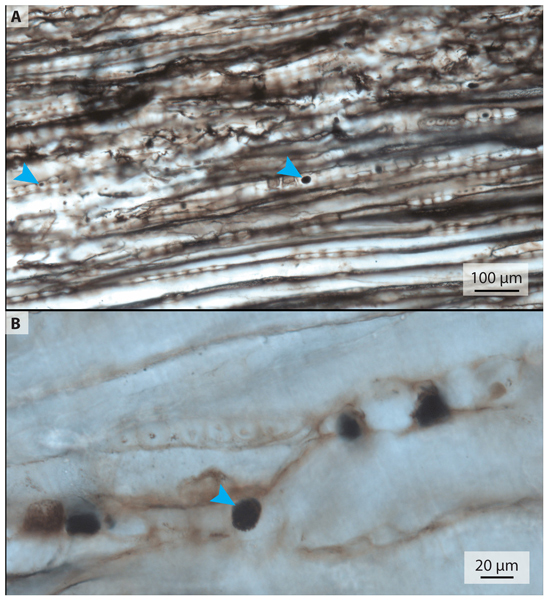Scientists from Virginia Tech and Des Moines University in the USA have challenged the idea that spheres identified under high magnification in thin sections of fossilised dinosaur bone are preserved fragments of dinosaur blood. The reddish coloured circular structures might not be remnants of blood cells, but instead they could be sediments that have been altered physically, chemically or via biological action to provide misleading data.
That is the conclusion made by the authors of a scientific paper published recently in the peer-reviewed, open-access journal PeerJ.

Photograph of sampled specimen (Beipiaosaurus inexpectus, IVPP V11559) (A) and transmitted light micrographs of representative thin sections (B–D). In the section images black arrows indicate spheres (putatively identified as red blood cells), white arrows indicate osteocyte lacunae and grey arrows indicate non-spherical vessel fills. The researchers suggest the spheres are not evidence of dinosaur blood. Picture credit: Korneisel et al.
Picture credit: Korneisel et al
Analysing the Holotype of Beipiaosaurus inexpectus
The researchers, who included Sterling J. Nesbitt (Department of Geosciences at Virginia Tech), analysed thin sections of bone from the holotype of the Chinese therizinosaur Beipiaosaurus inexpectus from the Jehol Lagerstätte. The fossil specimen (IVPP V11559) consists of both cranial and postcranial elements and it was found in sediments representing the Yixian Formation. This specimen was the subject of a paper earlier this year, remarkably when B. inexpectus was scientifically described only the skull elements were examined in detail. In October (2021), Everything Dinosaur published a blog post on the study of the postcranial material which provided more anatomical traits to help define this genus and clarify the evolution of the Therizinosauridae.
Our post can be found here: Beipiaosaurus Revisited.
In this study, the researchers employed a variety of sophisticated techniques including Ramon spectroscopy, X-ray spectrometry and Time of flight – secondary ion mass spectrometry to analyse thin sections of fossil bone from the Beipiaosaurus and compare them to similarly prepared thin sections of fossilised wood.
The team found that the bone had been dramatically altered by the fossilisation process (taphonomy). Vascular canals in the bone, once thought to contain preserved red blood cells, were filled with a mix of clay minerals and carbonaceous compounds. The spheres that were identified could not be analysed in isolation, but the researchers did not find any evidence of pyrite or haemoglobin fragments associated with a concentration of iron.
However, similar spheres were identified in the thin sections of fossilised wood which were found close to the Beipiaosaurus fossils and as such, had presumably been subjected to the same taphonomic processes.

Transmitted light micrographs of fossil wood found near to the dinosaur fossil material seem to show similar, microscopic spherical structures. The blue arrows highlight small and large examples. At higher magnification (B) these spheres appear to consist of small crystals. Picture credit: Korneisel at al.
Picture credit: Korneisel et al
The researchers concluded that the reddish coloured spheres were not evidence of dinosaur blood, but more likely structures formed by diagenesis. Diagenesis is the process whereby sediments in sedimentary rocks are altered by the interaction of water, microbial activity or by physical and chemical processes.
This research suggests that further study of alleged red blood cells associated with fossil bone is required in order to confirm the assertions made in previous papers.
The scientific paper: “Putative fossil blood cells reinterpreted as diagenetic structures” by Dana E. Korneisel, Sterling J. Nesbitt, Sarah Werning and Shuhai Xiao published in PeerJ.
The award-winning Everything Dinosaur website: Dinosaur Models and Figures.






Leave A Comment